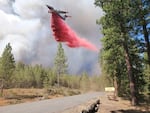
In this photo provided by the Bootleg Fire Incident Command, a plane drops retardant near Mitchell Monument in the Bootleg Fire, July 19, 2021.
Bootleg Fire Incident Command via InciWeb
Central Oregon has the highest fire risk of anywhere in the state heading into the summer.
The latest fire season outlook, released this week by the National Interagency Fire Center, shows above-normal fire risk running down the middle of Oregon from the Columbia River to the California border for the month of May.
Meteorologist John Saltenberger with the Northwest Interagency Coordination Center in Portland says that while the risk of high-severity fire in the region is low, persistent drought in Central Oregon could lead to combustible conditions.
“We do anticipate that on dry, windy days, if we get some of those in May, that there is risk of fires escaping,” Saltenberger said.
The outlook shows above-normal fire risk spreading across the state as the season progresses, snaking into southwest Oregon in July, then covering the majority of Oregon and Central Washington by August.
That’s despite bountiful late-season precipitation in some parts of the Northwest.
Portland broke its rainfall record for April. Portions of Western Oregon and the Columbia River Gorge were similarly drenched. The precipitation contributed to snowpack in higher elevations.
While above-average precipitation and snowpack can lessen an area’s wildfire risk, Saltenberger said the top factor is summer weather, especially wind and lightning.
“I’ve seen years where we had plenty of rain and snow in the winter, and by August we had a lot of fire around both Oregon and Washington,” Saltenberger said. “And I’ve seen other years where it’s been quite dry, and we didn’t wind up with that severe of a fire season.”
The National Oceanic and Atmospheric Administration projects areas east of the Cascades are likely to experience above-average temperatures, while almost the entire Pacific Northwest is likely to see below-average precipitation this summer.
The region’s climate is also trending drier.
Oregon and Washington are experiencing fewer cool, wet days, especially during the fire season. That sets conditions for new ignitions to grow into bigger fires and allows existing fires to continue burning.
“Does it seem like fire seasons have been getting worse in the last decade in the Pacific Northwest?” Saltenberger said. “The answer is emphatically yes.”
Nearly 830,000 acres burned in 2,202 fires in Oregon last year, according to NIFC statistics, with about half of the acreage burning in the Bootleg Fire in Southern Oregon. Almost 675,000 acres burned in 1,863 fires in Washington.
